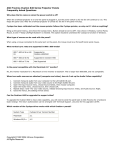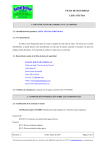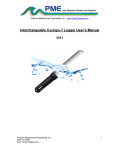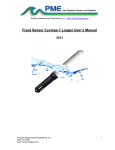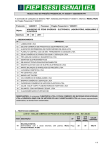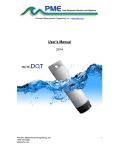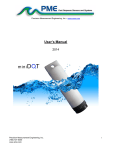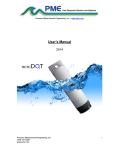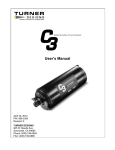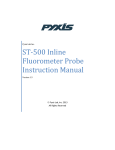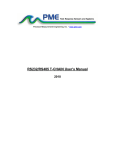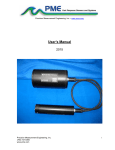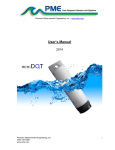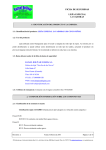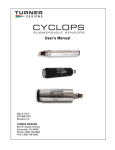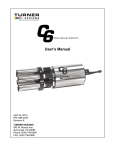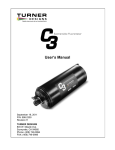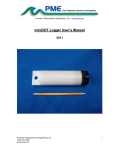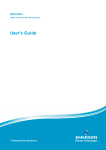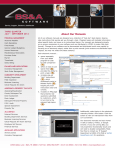Download USB Cyclops-7 Logger User`s Manual (Interchangeable and
Transcript
Precision Measurement Engineering, Inc. • www.Turner Designs.com USB Cyclops-7 Logger User’s Manual (Interchangeable and Fixed Sensors) 2015 Precision Measurement Engineering, Inc. (760) 727-0300 www.Turner Designs.com 1 (INTENTIONALLY BLANK) Precision Measurement Engineering, Inc. (760) 727-0300 www.Turner Designs.com 2 Warranty 1-YEAR LIMITED WARRANTY Precision Measurement Engineering, Inc. warrant that the Logger shall be free of defects in workmanship and materials, under normal use, for a period of one year from the date of shipment. This warranty is made only to the original purchaser. In the event a Logger covered by this warranty fails to operate according to our published specifications, then return it freight pre-paid to Precision Measurement Engineering or an authorized Service Provider. Precision Measurement Engineering (PME) will repair the unit at no charge to the customer and bear the cost of return shipment to customer. Carefully pack all components, as the customer is responsible for any freight damage. This warranty does not apply to services or consumable / expendable items (such as batteries, fuses and ropes) required for general maintenance. The Cyclops-7 sensor, manufactured by Turner Designs, is warranted only to the limit of the warranties provided by their original manufacturer. PME makes no warranty, either expressed or implied, that the sensors will be operable after they are exposed to adverse environmental conditions, such as biofouling, oil fouling, freezing temperatures or others. This warranty is void if, in our opinion, the Logger has been damaged by accident, mishandled, altered, or repaired by the customer, where such treatment has affected its performance or reliability. In the event of such treatment by the customer, costs for repairs plus two-way freight costs (no COD shipments will be accepted) will be borne by the customer. In such cases, an estimate will be submitted for approval before repair work is started. Items found to be defective should be returned to PME carefully packed, as the customer will be responsible for freight damage. Incidental or consequential damages or costs incurred as a result of the product malfunction are not the responsibility of PME. For all warranty or non-warranty returns please obtain, complete, and submit a RMA to PME. This RMA form may be obtained at http://www.pme.com/HTML%20Docs/RMAform.html After submission of this form, then PME will respond with a RMA number. Please place this number on all shipments and related communications. Precision Measurement Engineering, Inc. (760) 727-0300 www.Turner Designs.com 3 Safety Information BURSTING HAZARD Should water enter the Cyclops-7 Logger and come into contact with the enclosed batteries, then the batteries may generate gas causing the internal pressure to increase. This gas will likely exit via the same location where the water entered, but not necessarily. The Cyclops-7 Logger is designed to release internal pressure as the end cap is unscrewed, prior to the disengagement of the end cap threads. If internal pressure is suspected, then treat the Cyclops-7 Logger with extreme caution. Revision History Date 2015FEB24 2015APR16 2015APR28 2015MAY08 2015MAY25 2015JUN25 Revision Description Copied from RS232 C7 manual Added Android device instructions Updated wording Inserted pictures in Chapter 3 Released for distribution to customer Added evaluation of calibration result Precision Measurement Engineering, Inc. (760) 727-0300 www.Turner Designs.com 4 CONTENTS Chapter 1 Quick Start 1.1 Calibrate and Go 1.2 A Few Details Chapter 2 Software 2.1 2.2 2.3 2.4 Overview and Software Installation Cyc7Control Cyc7Plot Cyc7Concatenate Chapter 3 Cyclops-7 Logger 3.1 3.2 3.3 3.4 3.5 Overview Opening and Closing the Logger Electrical Connections and Controls Battery Replacement Interchangeable Sensor Installation Precision Measurement Engineering, Inc. (760) 727-0300 www.Turner Designs.com 5 Chapter 1: Quick Start 1.1 Calibrate and Go PME produces two types of loggers, a logger with the sensor permanently installed and a logger with a connector that you will use to plug in your own sensor. Even if the sensor is already installed, the logger/sensor are provided to you in an uncalibrated state. The logger itself is set to measure temperature and concentration once every 10 minutes and record 1 file of measurements daily. However, you must calibrate the sensor before the system can be used. At one measurement every 10 minutes the Cyclops-7 Logger will operate for roughly a half year before the internal battery is expended. At the end of the deployment period you need only to open the logger and connect it to a host device via USB. The Cyclops-7 Logger will appear as a ‘thumb drive’. Your temperature and sensor measurements, together with a time stamp indicating the time the measurement was made, are recorded in text files in the folder having the serial number of your Cyclops-7 Logger. These files can be copied onto any Windows or Mac host computer. This Manual and other software is supplied in files on the Cyclops-7 Logger: • • • Cyc7Control allows you to see the state of the logger as well as set the recording interval. Cyc7Plot allows you to see plots of the recorded measurements. C7Concatenate gathers all the daily files into one CAT.txt file. When not connected to USB, your Cyclops-7 Logger will record measurements if the Recording Control Switch is in the Record position. If you wish to stop recording, switch the Recording Control Switch to the Halt position. You may switch the Recording Control Switch at any time. Follow these steps to start the deployment, logging Cyclops-7 output and Temperature once each 10 minutes: 1) Install your sensor onto the logger if required as described in Chapter 3. 2) Calibrate the sensor/logger as described in Chapter 2, Cyc7Control program. 3) Open the Cyclops-7 Logger (if not already open from calibration) as described in Chapter 3. 4) Switch the Recording Control Switch to the Record position. The LED will flash green 5 times. The Cyclops-7 Logger will now record a measurement of time, Precision Measurement Engineering, Inc. (760) 727-0300 www.Turner Designs.com 6 battery voltage, temperature, and sensor output every 10 minutes (or at some other interval you may have set using Cyc7Control). 5) Inspect the o-ring seal for debris. 6) Close the Cyclops-7 Logger by screwing the white housing back onto the black end cap. 7) Deploy the Cyclops-7 Logger. Follow these steps to end the deployment 1) 2) 3) 4) Recover the Cyclops-7 Logger Clean and dry all accessible surfaces. Open the Cyclops-7 as described in Chapter 3. Connect to a Windows host computer via USB. The Cyclops-7 Logger will appear as a ‘thumb drive’. 5) Copy the folder having the same serial number as the Cyclops-7 Logger (example 7377-191770) to the host computer. 6) (Suggested, but optional) Delete the measurement folder, but NOT Cyc7Control or the other .jar programs or manual. 7) (Optionally) run the Cyc7Plot program to see a plot of measurements. 8) (Optionally) Run the C7Concatenate program to gather together all the daily files of measurements into one CAT.txt file. 9) If no more recording is desired, switch the Recording Control Switch to Halt, otherwise leave it set to Record to begin recording after USB disconnection. 10) Disconnect the Cyclops-7 Logger from the USB connection. 11) Inspect the o-ring seal for debris. 12) Close the Cyclops-7 Logger by screwing the white housing back onto the black end cap. Remove the batteries if storing the Cyclops-7 Logger for extended periods. 1.2 A Few Details The previous section gives instructions for sampling at 10-minute intervals. However there are a few additional details that will enhance use of the Cyclops-7 Logger. Sensor guard – The sensor guard is the long tube having slots in the end that covers the Turner C7 sensor. This guard not only protects the sensor but also establishes a consistent field of view for the sensor. The guard must be used when the sensor is calibrated and also when it is used for measurements in the field. Sampling rate – The Cyclops-7 Logger records measurements at equal time intervals. The default time interval is 10 minutes. However, it is also possible to instruct the Cyclops-7 Logger to record at different intervals. This is accomplished by connecting a Windows computer to the logger and using the Cyc7Control program supplied for this purpose. Recording intervals must be 1 or more minutes and must be less than or equal to 60 minutes. Intervals outside this range will be rejected by Cyc7Control. (Contact PME for other recording intervals.) Precision Measurement Engineering, Inc. (760) 727-0300 www.Turner Designs.com 7 Please refer to Chapter 2 for instructions on operating the Cyc7Control program. Time – All Cyclops-7 Logger times are UTC (formerly known as Greenwich mean time (GMT)). The Cyclops-7 Logger internal clock will drift in the < 10 ppm range (<about 30 secnds/month) so you should plan to connect it occasionally to a host having an internet connection. The Cyc7Control program will automatically set time based on an internet time server. Please refer to Chapter 2 for instructions on operating the Cyc7Control program. File Information – The Cyclops-7 Logger software creates 1 file daily on the Cyclops-7 Logger’s internal SD card.. The number of measurements in each file will depend upon the sample interval. Files are named by the time of the first measurement within the file based on the logger’s internal clock and expressed in YYYY-MM-DD HHMMSSZ.txt format. For example a file having the first measurement on September 9, 2014 at 17:39:00 UTC will be named 2014-09-09 173900Z.txt Files can be uploaded from the Cyclops-7 Logger by connecting the Logger to a host computer and by using the host computer to copy/past the files from Logger to some host computer storage. Each measurement within files has a time stamp. The time stamp format is Unix Epoch 1970, the number of seconds that have passed since the first moment of 1970. This may be inconvenient in some cases. If so, the C7Concatenate software not only concatenates all the measurement files but also adds more readable statements of the time stamp. Please refer to Chapter 2 for instructions on operating the C7Concatenate program. The Cyclops-7 Logger requires time and battery energy to work through the file directory on SD card to allocate new file space. A few hundred files on SD is not a problem, but as the number of files grows large into the thousands the Logger may suffer decreased battery life or other performance problems. Please, at the earliest convenient time, copy recorded files to a host computer and delete them from the Logger. Also, do not use the Logger to store files unrelated to Logger operation. Cleaning the Sensor – The sensor may be cleaned by unscrewing the black sensor guard and gently wiping the optical face. Battery Life – The Cyclops-7 Logger consumes battery power mostly from the Cyclops-7 sensor, but also slightly from simply keeping track of time, writing files, sleeping, and other activities. The Cyclops-7 Logger will record approximately 30,000 total samples and will operate for up to a year (depending on sample interval) when powered by the battery pack (2 X alkaline ‘C’ cells) supplied by PME. Precision Measurement Engineering, Inc. (760) 727-0300 www.Turner Designs.com 8 Keep a general record of Cyclops-7 Logger number of samples. It is not possible to accurately determine the charge state of the battery pack from measurements of its terminal voltage. If you have a general idea of the number of samples already obtained on a battery, then you can make a guess as to how many more samples remain. Err on the side of caution. The 2 X ‘C’ battery pack holds the batteries very tightly. The holder itself is glued to the aluminum chassis. Take care when changing batteries that the glue joint is not broken. Always use the paper tube supplied with the Cyclops-7 to contain the batteries. Use only new batteries as replacements. Coin Cell Battery Life – The Cyclops-7 Logger uses a coin cell for backup of the clock when the power is switched off. This coin cell will supply roughly 2 years of clock operation, but this is only required if the main power is off. Should the coin cell discharge it must be replaced. Coin cells are not user-replaceable. O-Ring and Seal – When the cover is screwed on, it passes along the o-ring located in the end cap several revolutions. Keep this o-ring lightly lubricated with silicone grease or oil compatible with buna-N o-ring material. When the Cyclops-7 Logger is opened after deployment, a small number of water drops are deposited on the inner surface of the o-ring. When the pressure housing is screwed back on, these drops become trapped inside the Cyclops-7 Logger. Be sure to carefully dry the o-ring and adjacent surfaces (especially underneath) prior to closing the Cyclops-7. Re-lube the o-ring at this time. Remove any debris from the drying process. Closing the Logger – The logger is much more difficult to open than to close. Screw the white logger housing onto the black cap until the housing touches the cap. No further tightening is necessary. LED Indications – The Cyclops-7 Logger performs various tests as it begins logging operations. If any test fails the software flashes the LED light and re-conducts the test. In general if a test fails once it will continue to fail and the LED light will continue to flash. The following table gives the number of flashes and the reason these flashes appear. Precision Measurement Engineering, Inc. (760) 727-0300 www.Turner Designs.com 9 LED 1 Green Flash 1 Green Flash 5 Green Flashes 5 Red Flashes Continuously Green Continuously Flashing Red Reason Normal. Presented immediately after new batteries are installed. Indicates that the CPU has started its program. Occurs at the time of sampling for sample intervals of 1 minute or less. Normal. Indicates that miniDOT is beginning to record measurements. This indication appears in response to switching the Recording Control Switch to Record. Normal. Indicates the miniDOT is ending recording of measurements. This indication appears in response to switching the Recording Control Switch to Halt. Normal. Indicates the miniDOT is connected to a host device via USB. SD card write error. Try removing/reinstalling batteries. Contact PME. AutoRanging – The Cyclops-7 sensor has three output ranges: 1X, 10X and 100X. The best of these ranges is automatically selected by the logger based on the voltage measured of the sensor. The logger software remembers the best range and, at each sample time, first measures sensor output voltage using this range. Software then reviews this voltage to determine if the range was appropriate. In most cases the range will be appropriate and the measurement is recorded. However sometimes software determines that a different range would yield a better measurement. In this case software selects a new “best range” and re-measures the sensor output voltage using this range. This new best range becomes the range selected at the next sample time. The best range is determined as follows: Sensor Voltage 0.00 to 0.04 0.04 to 0.4 0.4 and higher Best Range 100X 10X 1X Should the first voltage measurement be unacceptably close to the sensor maximum output voltage (an over-range condition) the first voltage is re-measured using range of 1X and the best range calculated. This range becomes the best range and software proceeds as above. Calculation of Engineering Units – Engineering units are calculated from voltage measurements of the sensor and from information gained during calibration (see Chapter 4). The result of calibration is the following information: Name Vz1 Vz10 Definition Voltage output of sensor in zero solution on range 1X Voltage output of sensor in zero solution on range 10X Precision Measurement Engineering, Inc. (760) 727-0300 www.Turner Designs.com 10 Vz100 S Voltage output of sensor in zero solution on range 100X Sensitivity of sensor Vz1, Vz10, and Vz100 are measured with the sensor in a solution of zero concentration. S is determined from the voltage output of the sensor using the “best range”, described above, with the sensor in a reference solution of known concentration. The user must enter the concentration value of this solution, given the name C. The sensor voltage is measured in this solution and given the name Vs. The following table shows how S is determined. Range 1X 10X 100X S S = C / (Vs – Vz1) S = 10.0 * C / (Vs – Vz10) S = 100 * C / (Vs – Vz100) Note that since only one calibration concentration is actually measured, there is only one S determined. However this S is used to compute engineering units from the other ranges should these be implemented by the logger during the measurement of samples. Engineering units are computed as shown in the following table: Range 1X 10X 100X EU EU = S * (Vs – Vz1) EU = S * (Vs– Vz10) / 10.0 EU = S * (Vs– Vz100) / 100.0 Engineering units computed using the same range that was used to determine S will be more accurate than engineering units computed using other ranges since the sensor may not exactly implement ranges. For example the 100X range may actually be implemented by circuitry as 100.1X but the calculations would use 100X. Closing and Opening – Close and open Cyclops-7 Logger like you would a flashlight: open by unscrewing the white cylinder from the black end cap. Close by screwing the white cylinder on. When closing, do not tighten the white cylinder. Just screw it on until it makes contact with the black end cap. See Chapter 3 for more instructions. Storage When Not in Use – Remove the batteries. Java – miniDOT programs depend on Java and require Java 1.7 or higher. Update Java at https://java.com/en/download/index.jsp Precision Measurement Engineering, Inc. (760) 727-0300 www.Turner Designs.com 11 Upload Files to an Android device – It is possible to transfer your measurement files from your logger to an android device. This operation has 3 prerequisites. 1. An Android device equipped with USB On-The-Go (OTG). OTG is a feature on most modern Android devices that allows them to act as a USB host. OTG was introduced with Android version 3.1 and should be a useable feature on most devices. It is still possible that your device doesn't support OTG. Please test your device with a logger prior to attempting to upload while in the field. 2. A USB OTG cable. This is essentially an adapter with a micro USB connector on one end that connects to your Android device and a standard A type USB plug on the other. The cable supplied with the logger connects to this end. 3. A "File Explorer" app downloaded on your Android device. These types of apps assist with being able to view and move files from device to device. "ES File Explorer" is a free app available on the Google app store and is recommended for use with the logger. If the 3 requirements are met, then connect the logger to your device. You should see the logger green connection light come on and your device display a message about "preparing USB storage". When "USB storage ready" is shown, use your "file explorer" program to move your data from the logger onto you device. Again, it is highly recommended that you try this operation at your work station prior to depending upon this in the field. Currently the associated logger programs, Control, Plot, and Concatenate, are not supported by Android devices. Precision Measurement Engineering, Inc. (760) 727-0300 www.Turner Designs.com 12 Chapter 2: Software 2.1 Overview and Software Installation The miniDOT arrives with these files: • • • • Cyc7Control.jar allows you to see the state of the logger as well as set the recording interval. Cyc7Plot.jar allows you to see plots of the recorded measurements. C7Concatenate.jar gathers all the daily files into one CAT.txt file. Manual.pdf this manual. These files are located on the root directory of the Cyclops-7 Logger. PME suggests you leave these programs where they are on the Logger, but you may copy them to any folder on your computer’s hard drive. Cyc7Control, Cyc7Plot, and C7Concatenate are Java language programs that require the host computer to have the Java Runtime Engine V1.7 (JRE) or later installed. This engine is commonly required for internet applications and will likely already be installed on the host computer. You can test this by running Cyc7Plot. If this program displays its graphical user interface then the JRE is installed. If not then the JRE can be downloaded via internet from http://www.java.com/en/download/windows_xpi.jsp At this time Cyclops-7 Logger software is supported on Windows operating systems, but may also operate on Macintosh and perhaps Linux. 2.1 Cyc7Control The Cyc7Control program provides these services: • • • It enables time setting (based on internet timeserver clock). It enables sample interval setting. It enables calibration of the sensor. Turner C7 sensors, are not factory calibrated. Calibration must be physically performed by the customer. Calibration consists of an experiment where the sensor is exposed to two solutions, the first having 0 concentration of the sensed material (chl-a, rhodamineQ whatever the C7 sensor senses) and a second solution having a known concentration created by the customer. Cyc7Control software records sensor output in each solution and creates a linear fit to these two points. After calibration the Cyclops 7 Logger will measure sensor output and record it in engineering units using this linear fit. Precision Measurement Engineering, Inc. (760) 727-0300 www.Turner Designs.com 13 Begin program operation by clicking on Cyc7Control.jar. Software presents the screen shown below: The Cyclops-7 Logger must be connected to USB at this time. When correctly connected the Logger will display a constant green light. Precision Measurement Engineering, Inc. (760) 727-0300 www.Turner Designs.com 14 Click the Connect button. The software will contact the logger. If the connection is successful the button will turn green and display “Connected”. The Serial Number and other parameters will be filled in from information take from the Logger. If the host computer is connected to the internet, the current difference between an internet time server’s time and the Logger internal clock will be displayed. And, if more than a week has passed since time was last set, the Logger clock will be set and check mark icon will appear. If the host computer is not connected to the internet no time services will occur. The current Logger sample interval will be displayed next to the Set Sample Interval button. If this interval is acceptable the interval need not be set. To set the interval, enter a interval not less than 1 minute and not greater than 60 minutes. Click the Set Sample Interval button. Shorter and faster intervals are available. Contact PME. Turner C7 sensors are optical devices that operate by sending colored light into the water and observing how much light returns. The field of view available to these sensors is quite important in establishing their response. PME’s Cyclops 7 Logger is supplied with a sensor cover that not only protects the sensor from damage but also establishes the field of view. This cover has slots near where it covers the sensor so that exterior water can enter and be sensed. The sensor cover must be in position when the sensor is calibrated and must be in the same position when the sensor is used. A small amount of light can exit through the sensor cover slots, be reflected by the container holding the calibration solution, and return. Calibrate the sensor in black containers. Exterior light such as room lighting or sunlight can enter through the slots and cause a very small measurement effect. Attempt to calibrate in the same lighting as the system will experience in field use. Be sure that there are no bubbles trapped in the cover or stuck on the sensor. Calibration proceeds by dipping the system in one solution and then the next. Take care not to transport one solution to the next. Mix two 0 solutions and two solutions of the sensed material. Label one each as the “calibration” and one each as the “wash” When moving the sensor back and forth first dip the sensor in the wash then into the calibration. The most noticeable effect is when the 0 solution is contaminated prior to calibration. If the 0 solution is contaminated and is actually 1, and if this is not noticed and the value 0 is entered into Cyc7Control, then later in a truly 0 solution the Cyclops 7 Logger will be indicated as a concentration of –1. A negative concentration can not exist and so the sensor is suspected of poor measurement when the problem is that it was poorly calibrated. Precision Measurement Engineering, Inc. (760) 727-0300 www.Turner Designs.com 15 Cyc7Control requires that the host computer be connected to the Cyclops 7 Logger at the time the calibration is performed. The logger must be open at this time. Take care that no calibrating solutions splash onto logger circuits. When calibration is completed, use the sensor to log measurements in each calibration solution. Do this right away using the same solutions that were used for calibration. The values 0 and the known concentration should be recorded by the logger. This gives a check on the results of calibration. Cyclops-7 Loggers support various Turner Cyclops-7 sensors. The sensor type is shown on a small tag inside the logger. Sensors are calibrated in response to the Calibrate button, after both the Unit of Measure and the Calibration Value are entered. Enter the unit of measure that is appropriate for the Cyclops 7 sensor mounted on the logger. Enter the calibration value for the solution. Click on the Calibrate button. The adjacent scroll bar shows how far the program has progress through the calibration procedure. Precision Measurement Engineering, Inc. (760) 727-0300 www.Turner Designs.com 16 A dialog window appears instructing you to place the sensor in the zero solution. This will most likely simply be clear water contained in a bucket. Whatever the solution, the sensor after calibration will report 0 when returned to this solution. Click OK when the sensor is suitably positioned. If this solution is NOT 0 and the sensor is later placed into a solution that IS 0 the sensor will report a negative concentration! Negative concentration values can also result if the reflected light in a later solution is less. Precision Measurement Engineering, Inc. (760) 727-0300 www.Turner Designs.com 17 At this time the software reads information from the sensor, selecting all three ranges of the sensor sensitivity. When this is completed a Zeroing of sensor completed dialog appears. Click OK. Precision Measurement Engineering, Inc. (760) 727-0300 www.Turner Designs.com 18 A “Please place sensor in calibration standard of <Calibration Value> (<Unit of Measure>)” dialog appears. In the screen shot above the value of 400 (ppb) is displayed. This information is taken from the Unit of Measure and Calibration Value text boxes and will be whatever is entered in the boxes. Place the sensor in the calibration solution. Whatever the solution, the sensor after calibration will report the calibration value (400 ppb in the above example) when Precision Measurement Engineering, Inc. (760) 727-0300 www.Turner Designs.com 19 returned to this solution. The same considerations about solution accuracy and reflected light apply in a similar way to those a zeroing. Click OK. At this time the software reads information from the sensor, selecting the best sensitivity range. When this is completed a “Calibration completed” dialog window appears along with the actual calibration results. Precision Measurement Engineering, Inc. (760) 727-0300 www.Turner Designs.com 20 Notice that calibration information is displayed in the bottom window. Also, this information is automatically transmitted to the Cyclops-7 Logger. The Logger is now calibrated. Click OK. At this time the calibration is saved on the Cyclops-7 Logger SD card. Note that the calibration has been installed in the sensor and the sensor is calibrated no matter if the results are saved on disk or not. Precision Measurement Engineering, Inc. (760) 727-0300 www.Turner Designs.com 21 A dialog window appears indicating the location where the calibration has been saved. You may later use the host computer’s file copy/paste to move this file to some host computer location. You may choose to leave the file on Logger SD or delete it. You may read the saved file later using a text file editor. The file will be similar to this file except that “test” will be replaced with the unit of measure selected for calibration. Precision Measurement Engineering, Inc. (760) 727-0300 www.Turner Designs.com 22 ================================================ Turner Cyclops 7 Logger Calibration Date: Oct 17, 2014 14:54:13 S/N: 18 Battery: 3.103 (V) Unit of Measure: test ================================================ Gain = 1, Sensor Output in Zero Solution, Vz1: 0.015335 (Volts) Gain = 10, Sensor Output in Zero Solution, Vz10: 0.018888 (Volts) Gain = 100, Sensor Output in Zero Solution, Vz100: 0.066867 (Volts) Gain = 1, Sensor Output in 100.0(test) Solution: 1.22355 (Volts) Gain = 1 Sensor Sensitivity (Measured at Gain = 1): 82.76672612076494 (test/Volt) A note about judging your calibration result: The table below presents typical values that result from calibration. Sensor Solution Rhodamine (1) Phycocanin (2) PTSA (3) Optical Brighteners CDOM (3) (3) Crude Oil (3) Turbidity (4) Fluorescein (5) Phycoerythrin (6) in vivo Chlorophyll (7) (1) (2) (3) (4) (5) (6) (7) Vz1 (Volt) 0 to 0.035 0 to 0.035 0 to 0.035 0 to 0.035 0 to 0.035 0 to 0.035 0 to 0.035 0 to 0.035 0 to 0.035 0 to 0.035 Vz10 (Volt) 0 to 0.075 Vz100 (Volt) 5 to 0.150 Sensitivity (Unit) 200 Unit 0 to 0.075 5 to 0.150 8000 ppb/Volt 0 to 0.200 0 to 0.500 130 ppb/Volt 0 to 0.200 0 to 0.500 3000 ppb/Volt 0 to 0.200 0 to 0.500 1000 ppb/Volt 0 to 0.200 0 to 0.500 540 ppb/Volt 0 to 0.075 0.005 to 0.150 0.005 to 0.150 0 to 0.500 600 NTU/Volt 100 ppb/Volt 150 ppb/Volt 100 ug/l 0 to 0.075 0 to 0.075 0 to 0.075 0.005 to 0.200 ppb/Volt Rhodamine dye diluted in deionized water. Specific species pigment diluted in deionized water PTSA (1, 3, 6, 8 - Pyrenetetrasulfonic Acid Tetrasodium Salt) calibration standard Amco Clear Turbidity Standard Solutions Fluorescein dye diluted in artificial sea water. Phycoerythrin pigment diluted in Deionized water algal monoculture consisting of the species Skeletonena costatum. Sensor calibrations should always show Vz1..Vz100 in the ranges given. The sensitivity can vary but variations larger than +/- 20% should be suspect. Also note that sensors can only produce as much as 5 Volts at their lowest sensitivity. Therefore your reference solutions have a maximum concentration that can be sensed. For example Rhodamine typical sensitivity is 200 ppb/Volt so only a Precision Measurement Engineering, Inc. (760) 727-0300 www.Turner Designs.com 23 maximum of 1000 ppb can be sensed. The “Sensor Output in xxx Solution” will always be less than 5.0 Volts since this is all the sensor can produce but should be less than 4.0 Volts. A note about Turner solid state secondary standards: These standards are not supplied with any calibration value, so they are not at first useful for calibration. However, once the sensor is calibrated the solid state secondary standard can be placed onto the sensor and adjusted so that the sensed value is some arbitrary value. Please refer to Turner’s documentation concerning the Solid Secondary Standard that is supplied with the standard or via the internet: http://www.turnerdesigns.com/t2/doc/instructions/998-6800.pdf Install the standard as described. The logger’s sensor guard must be unscrewed and removed for this procedure. Operationally, adjustment of a standard is not well implemented in the logger software. Step 2 of the Use of the Solid Secondary Standard for in vivo Chlorophyll Applications on page 1 of this document assumes that the sensor output can be viewed in real time. However this output can only be logged by the Cyclops-7 Logger. A short recording of the measurement must be made, and then the record reviewed, to determine the sensed value. The process must be repeated by trials to adjust the standard as described in the document. A note on chlorophyll calibration: Please review the Turner Designs document titled “In Vivo Chlorophyll: Concepts & Concerns”. PME sometimes provides this document together with this Manual or it can be found at Turner’s Application Notes http://www.turnerdesigns.com/customer-care/fluorometer-application-notes/chlorophyll-fluorometer-applicationnotes 2.2 Cyc7Plot The Cyc7Plot program provides the service of plotting Cyclops-7 Logger files. Begin program operation by clicking on C7Plot.jar. Software presents the screen shown below. Precision Measurement Engineering, Inc. (760) 727-0300 www.Turner Designs.com 24 C7Plot plots the files recorded by the Cyclops-7 Logger. The software reads all Logger files in a folder, except the CAT.txt file. Notice that the software has automatically suggested the Cyclops-7 Logger SD card as the Data Folder. You may accept this or click Select DATA Folder to find some other source for the plot. DATA folders MUST NOT contain any other files besides files written by the Cyclops7 Logger. This folder can be on the SD card from the Cyclops-7 or it can be from a copy of this on your computer’s hard drive. A few thousand measurements can be plotted directly from Cyclops-7 Logger SD. However it is best to copy large measurement sets to the host computer and select them there since file access to the Logger is slow. Press ‘Plot’ to begin measurement processing. The software reads all Cyclops-7 Logger data files in the Data presents a plot of the measurements similar to the plot shown below. Precision Measurement Engineering, Inc. (760) 727-0300 www.Turner Designs.com 25 You may zoom this plot by drawing a square from upper left to lower right (click and hold left mouse button) that defines the zoom region. To zoom completely out, attempt to draw a square from lower right to upper left. The mouse will scroll the image if the CTRL key is held down. Right click on the plot for options such as copy and print. The software may be run multiple times at the same time (select Data Folder, press Process, select new Data Folder, press Process...). In this case it produces multiple plots. Presently the plots are presented exactly on top of each other and so when a new plot appears it is not obvious that the old plot is still there. It is. Just move the new plot to see it. Closing any plot closes all. End C7Plot by closing any window. The software can be re-run at any time. If an already processed DATA Folder is selected the software simply reads the measurement files again. Special note: plotting of sample sets of more than 200K samples may consume all memory available to the host computer’s Java. C7Plot will present a partial plot and freeze in this case. A simple solution is to separate the files into multiple folders and plot each folder individually. Precision Measurement Engineering, Inc. (760) 727-0300 www.Turner Designs.com 26 2.3 Cyc7Concatenate The Cyc7Concatenate program provides these services: • • • It gathers together all Cyclops-7 Logger files in the DATA folder in time sequence. It translates the Logger time stamp into two additional formats. It writes all times and measurements into a single CAT.txt file in the DATA Folder. Begin program operation by clicking on Cyc7Concatenate.jar. Software presents the screen shown below. Cyc7Concatenate concatenates the files recorded by the Cyclops-7 Logger. The software reads all Logger files in a folder, except the CAT.txt file. Software translates Logger time stamps into two additional formats, and saves the result in a CAT.txt file in the DATA Folder. Notice that the software has automatically suggested the Cyclops-7 Logger SD card as the Data Folder. You may accept this or click Select DATA Folder to find some other source for the plot. DATA folders MUST NOT contain any other files besides files written by the Cyclops7 Logger. This folder can be on the SD card from the Cyclops-7 or it can be from a copy of this on your computer’s hard drive. A few thousand measurements can be concatenated directly from Cyclops-7 Logger SD. However it is best to copy large measurement sets to the host computer and select them there since file access to the Logger is slow. Press ‘Concatenate’ to begin measurement processing. The software reads all Cyclops-7 Logger data files in the DATA Folder. These are written to the same folder. Software presents a dialog window when the process is completed. Precision Measurement Engineering, Inc. (760) 727-0300 www.Turner Designs.com 27 Click OK. The Cyc7Concatenate software can be re-run at any time. End Cyc7Concatenate operation by closing the window. The CAT.txt file will resemble the following: Precision Measurement Engineering, Inc. (760) 727-0300 www.Turner Designs.com 28 Chapter 3: Cyclops-7 Logger 3.1 Overview All of the Cyclops-7 Logger measurements pass from the sensors onto the SD card it contains. Files are transferred to a host computer via USB connection where the Cyclops-7 Logger appears as a “thumb drive”. Measurements may be plotted by Cyc7Plot and files concatenated by Cyc7Concatenate. The Cyclops-7 Logger itself is controlled and calibrated by Cyc7Control. Customers are required to open the logger each time measurements are transferred to the host computer. This chapter describes the logger internal features. 3.2 Opening and Closing the Logger The logger circuitry is contained in a waterproof housing that must be opened. The housing is opened by unscrewing the white pressure housing from the black end cap. Turn the pressure housing counter clockwise relative to black end cap. Close by reversing this procedure after being sure that the o-ring is free from debris. Lube oring occasionally with grease intended for buna-n o-ring material. Precision Measurement Engineering, Inc. (760) 727-0300 www.Turner Designs.com 29 The logger is much more difficult to open than to close. Screw the white logger housing onto the black cap until the housing touches the cap. No further tightening is necessary. Please attempt to handle the Cyc7Logger only by the aluminum chassis, without touching the circuit card. When closing the Cyclops-7 Logger inspect the o-ring and interior of the white cylinder for debris, lube the o-ring, and screw the white cylinder onto the black end cap until the cylinder just touches the end cap. Do not Tighten! The Cyclops-7 Logger tends to get a little tighter during deployment. If you can not open the Cyclops-7 Logger by yourself, find another person with strong hands. This person should grip the black end cap while you turn the white cylinder. 3.3 Electrical Connections and Controls Removal of the cover reveals the logger connections and controls, shown below. The LED Light is a LED that can display either red or green light. This is used to indicate different features described in Chapter 1 in this manual. Precision Measurement Engineering, Inc. (760) 727-0300 www.Turner Designs.com 30 The Logger Control Switch controls the logger mode: • • Record – When the switch is in this position the logger is recording measurements. Halt – When the switch is in this position the logger is not recording and is sleeping at low power. The USB Connection allows communication between the logger and an external host computer. When connected, the logger is in halt mode regardless of the Logger Control Switch position. When disconnected the logger mode is controlled by the switch position. The switch position may be changed while the USB is connected. The Main Batteries (2 X “C” at right of picture above) provide main power to the Cyclops-7 Logger. Note the positive (+) terminal. 3.4 Battery Replacement Carefully remove both “C” cells, noting the direction of the (+) terminals. These both are oriented towards the Logger circuit. Insert new ‘C’ cells into the paper tube and re-install the pair into the battery holder. Take care not to break the glue connection between the holder and the aluminum chassis. 3.5 Interchangeable Sensor Installation PME provides two types of Cyclops-7 loggers. One type has the sensor permanently mounted by PME. This section describes the other type where the sensor is plugged to the logger. The other features described throughout this document are the same for both types of loggers. Arrange the parts as shown in the picture below Precision Measurement Engineering, Inc. (760) 727-0300 www.Turner Designs.com 31 The small circular black clip shown to the right of the C7 sensor will be found installed on the logger connector. This can be removed by unscrewing it from the connector, and then gently prying open the ‘C’ clip center piece. Screw one side of the clip fully on to the sensor. Screw the opposite side fully onto the connector as shown in the picture below. Precision Measurement Engineering, Inc. (760) 727-0300 www.Turner Designs.com 32 Be sure both are fully screwed on. If either is not, the clip will hold the sensor in a position where it may not make full contact with the connector. Plug the senor fully into the connector as shown in the picture below. Precision Measurement Engineering, Inc. (760) 727-0300 www.Turner Designs.com 33 The clip faces will mate. Note that if the clip is not fully screwed onto the connector it will still appear as shown in the picture above, but the sensor may not be making complete reliable contact with the logger. Snap the remaining clip part onto the clip to secure the sensor to clip connection. Precision Measurement Engineering, Inc. (760) 727-0300 www.Turner Designs.com 34 Slide the sensor support (middle-right in first picture) over the sensor. Note this part has an internal o-ring that comes against the sensor. This is not a water-proof seal. It’s purpose is to firmly secure the sensor within the support. Next screw the sensor guard (middle left in first picture) onto the sensor support. The completed assembly is shown in the picture below. Precision Measurement Engineering, Inc. (760) 727-0300 www.Turner Designs.com 35 When exchanging the sensor, reverse the process steps given above. The sensor connector is itself threaded into the logger end cap. This connector is tightened, but since the logger end cap is plastic there is a limit to how tightened this connector can be made. If the connector unscrews water can enter the logger and cause permanent damage. Be observant when installing sensors. When installed, the sensor should not be able to be rotated. Take care not to unscrew the sensor and watch the sensor when unscrewing the sensor support since the o-ring will apply a sight loosing rotation to the sensor. Should the sensor/connector become loose discontinue use of the logger and contact PME. Precision Measurement Engineering, Inc. (760) 727-0300 www.Turner Designs.com 36




































